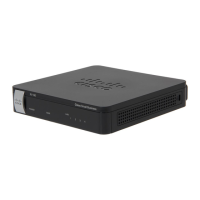Configuring Networking
Configuring the LAN (Local Network) Settings
Cisco RV180/RV180W Administration Guide 32
2
Configuring the LAN (Local Network) Settings
If you have an IPv4 network, use these sections to configure your LAN settings. If
you have an IPv6 network, see Configuring IPv6 LAN Properties, page 51.
Configuring IPv4 LAN (Local Network) Settings
If you have an IPv4 LAN, you can configure the following settings:
• Host name—Configuring the Host Name, page 32
• IP Address—Configuring the IP Address, page 32
• DHCP—Configuring DHCP, page 33
• DNS Proxy—Configuring the DNS Proxy, page 35
Configuring the Host Name
To configure the host name of the Cisco RV180/RV180W:
STEP 1 Choose Networking > LAN (Local Network) > IPv4 LAN (Local Network).
STEP 2 In the Host Name field, enter the host name of the Cisco RV180/RV180W. You can
use only alpha-numeric characters and the hyphen.
The default hostname (for example, “router6DE44E”) consists of the word “router”
followed by the last 3 bytes of the router’s LAN MAC address (in hexadecimal
form). This format allows the FindIT application to use Bonjour to identify Cisco
Small Business devices on the LAN.
NOTE: Changing the router name causes the router to reboot.
STEP 3 Click Save.
Configuring the IP Address
You might want to change the default IP address (for example, if the default
address is already assigned to another piece of equipment in your network).

